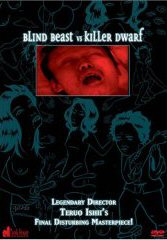
Unrepentant in its willingness to peel back the polite socially conservative skin of cultural taboo with fingers dipped as deeply in subversively thoughtful questions of society as they are in blood, Asian cinema has long been infamous for descending where others fear to tread. Celebrating perverse sexuality, pain, and the art of viscera in an excessive manner even more graphic than the heyday of Italian horror cinema (1970's-80's), BLIND BEAST is a punch in the guts to viewers used to the oh-so-predictable remake follies churned out by modern studios whose closest experience with fear is the possibility of losing their jobs. Defying the logic by which we are encouraged to define the world around us, BLIND BEAST exchanges realism for the symbolic meaning inherent in dreams, where despite surface contradictions of believability a strange hybrid of sense is established. This film is similar to the Expressionistic theater so popular at the turn of the century and the decadent symbolisms of Kakfa's fiction, evoking fear and wonder by challenging the dependability of the world and our senses.
Blind Beast interweaves brazen sexuality and startling viscera into a hand-basket of disturbing emotional intensity. Occurring in both the realm of physical need/excess and emotional epiphanies, this problem child of cinema more than makes up for its shot-on-video exterior with a story that celebrates such exploitation hallmarks as nudity, sex, and violence without loosing its soul to them. While grounded in excess, there is no denying the emotional intensity and occasional intellectual daringness of this story. Characters who are rounded out with explicitness and care. Monzo Kobayashi, an author of pulp fiction, watches stage starlet Ranko Mizuki in an all-girls' performance, "The Asakusa Revue." While there he discovers a mysterious, foreboding blind man sitting beside him. The night is just getting started, it seems, as Monzo spots a dwarf hurrying through the shadows with a woman's severed head in tow. These early events lead to a private investigation that, with the help of a private investigator, uncover murderous conspiracies of torture, murder, and sexual torment.
Similar to the writings of legendary Japanese Manga creator Yoshiharu Tsuge, who wrote the story upon which director Ishii based his film Screwed, Blind Beast, written by Edogawa Rampo, focuses on the relationship between Outsiders and society, particularly their crippling desires and the societies that both define and destroy them. The destructive nature of art, and fine line between genius and sanity, are themes that lend a philosophical relevance to a story full of righteous gore and rage.
A fascinating examination of the depraved depths of obsession, BLIND BEAST VS. KILLER DWARF is a modern attempt at exorcising primal anxieties. Morbidly fascinating and intellectually revealing, the movie attacks us at our most vulnerable while asking us to enjoy the experience! And we do; it's hard not to, for the director's eye for detail and the bold thematic implications entangle us with ease. And if the promises of the plot and the evocative atmosphere are not always realized, at times befuddled by a story that threatens to lose its characters within the veering of its disjointed (if fascinating) themes, the imagery is always engaging.
A testament to director Teruo Ishii's bold creativity, rebellious spirit, and love affair with the poetics of violent eroticism and death, this wonderfully presented, restored edition for once and all establishes the director's willingness to experiment, a clear picture inviting full appreciation of his imaginative approach to the outlandish. More importantly, it emphasis his abilities as a storyteller who has something to say, not simply an imagist throwing scattered chaos on the screen. Ishii's surrealism suggests universal truths within its absurdist moments of bloodshed and deviancy, and if they are epiphanies bathed in sweat, spittle, hate, and blood, than this is the nature of humanity, and his lens was a perfect eye with which to capture it.
Another example of Panik House's devotion to preserving rare and adventurous world cinema, Blind Beast vs. Killer Dwarf is treated here with respect. While nothing can disguise the shot-on-video quality of the movie (technology that cheapens the atmosphere of practically any shoot employing it), the picture, presented in full frame (1.33:1) is clean and crisp, with solid colors and no suggestion of splotching or other such surface anomalies. Audio is free from background noise or disruption, offered in Japanese Dolby Digital Surround Sound with optional English and Spanish subtitles.
Extras are a bit more substantial than in Screwed, providing opportunities to better appreciate the movie and the skill that went into it. The most impressive featurette is "Behind the Scenes: The Making of Blind Beast vs. Killer Dwarf," a lengthy documentary that combines raw footage with various interviews. In this collage we see cast and crew busily at work and play, prepping for scenes, saying lines, interacting before and after shots, and, most enjoyably, the filming of various scenes. Glimpses of set designs, effects, and sculptures are joined with various interviews with actors and crewmen, including Takao Nakano, Reika Hashimoto, Lilly Frank, and Sion Sono. Trailers roll next, including spots for the feature film, Screwed, and Tokyo Psycho. These are followed by production notes, informative bios, and "Geaphiles: Gallery of Conceptual Art," which features evocative illustrations by Gea, all of which embody the decadent mood and maddening atmosphere of the film. A sticker and numbered insert card, thrown in for good measure, round out this impressive package -- a tribute to one of the genre's most original thinkers.
Review by William P. Simmons
| Released by Panik House |
| Region 1 - NTSC |
| Not Rated |
| Extras : |
| see main review |